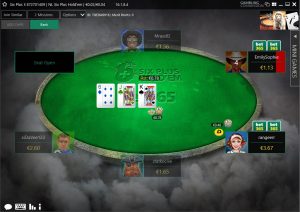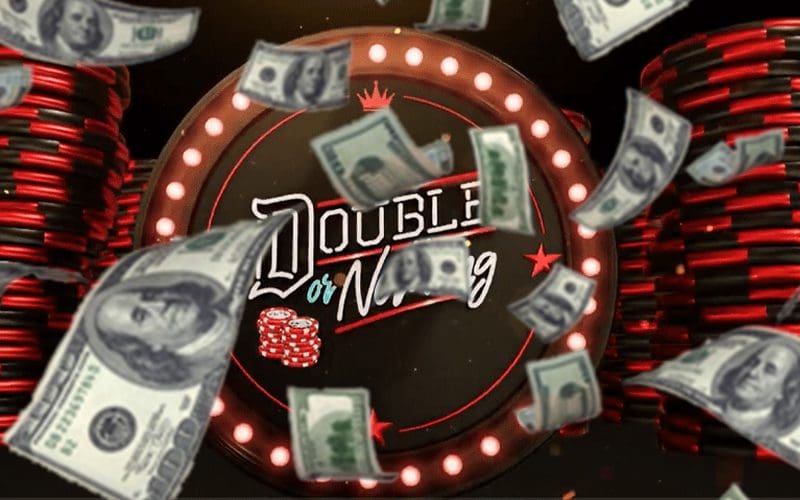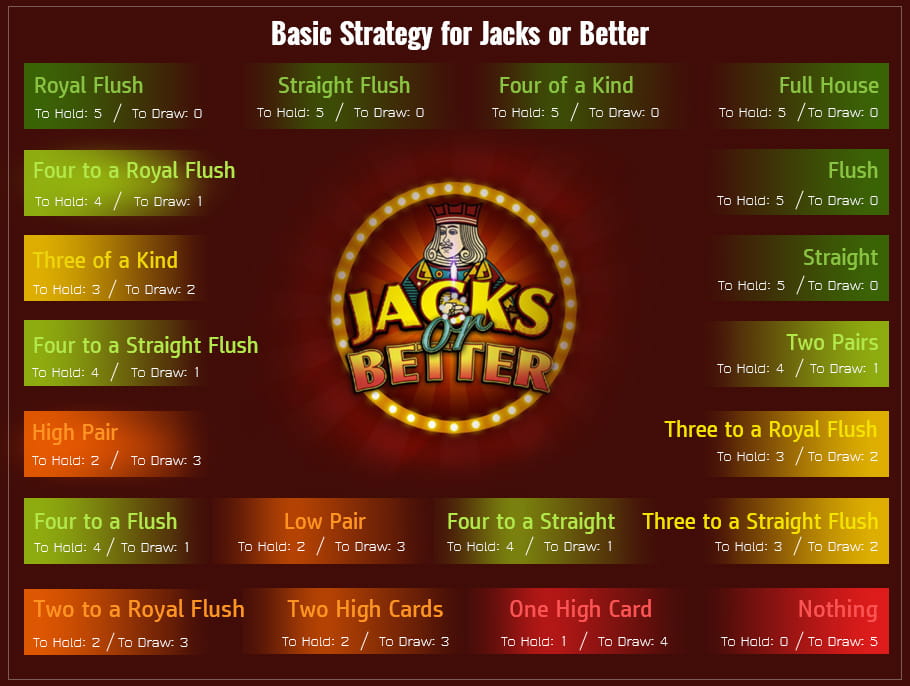Poker Double Or Nothing Profitable
At the risk of appearing way out of the loop, I will admit I just discovered the new-fangled “Double or Nothing” Sit & Gos on PokerStars. I know that they have been around for a while, but I just haven’t been playing on Stars lately. They have turned out to be very interesting, a nice change of pace from the standard Sit & Go. And even though almost every time I have been eliminated, I have had the best hand when the money went in (I’ve had Aces cracked three times!), I have had quite a lot of fun with them. This week, I would like to impart my wisdom upon you and share a bit of my strategy for these tournaments.
- Poker Double Or Nothing Profitable Stocks
- Poker Double Or Nothing Profitable Meaning
- Poker Double Or Nothing Profitable Strategy
For the uninitiated, “Double or Nothings” are 10-handed Sit & Gos starting with 1,500 chip stacks (on PokerStars), where the top five finishers win twice their buy-in and the other five get zero. “Double or Nothing” indeed! First place wins as much as fifth place. The nice thing about them is that since it is theoretically easier to make the money – since more people get paid and the payout structures are flat – variance is lower than in standard Sit & Gos. On the negative side, if you are very good at Sit & Gos, you will not be as profitable in these tournaments, as there is no added benefit to placing first. Plus, in order to profit, you must make the money two out of every three tournaments. Alternate wins and losses, and you lose money to the rake, which is high compared to the payouts.
Sit On Your Hands
If I had to boil my strategy down to two words, they would be “play tight.” I mean play really tight. Since first through fifth pay the same, there is little benefit to trying to accumulate chips. You don’t need to build up a huge stack to dominate the table. The guy who squeaks into the money with two big blinds wins the same amount as the gorilla stack. Early on, when the blinds are low, stick to playing only premium hands, especially from early position. As always, you can open it up more in late position, but don’t take unnecessary risks.
Even though I'm not a big fan of Online Poker, I have found one thing that seems to be quite profitable for me. Someone in the CPMG was kind enough to point me towards the 'Double or Nothing' Sit-N-Gos on PokerStars. On the surface, they would seem rather pointless. Ten players enter a $10+$1 tournament, and five of those players 'double up' to. To answer your question, there are no Nash Equilibria for most multiplayer poker games. A good discussion of this can be found in the Mathematics of poker where they point out that nash's theorem does not apply, that the proof cannot be extended to include such case. And I believe they even give a concrete example.
Your goal is to tread water for a while. If you can stay around your starting chip stack for a few levels, you’ll be in good shape. Let players who don’t know what they are doing bust out around you. Of course, if you can find a good, high percentage opportunity to double-up, take it. While you don’t need to accumulate chips in the traditional sense of the term, if you can bring in a nice haul in a hand or two, you go on cruise control for a while and fold your way to at least the bubble.
- It's more profitable to try to double-up several times after a big win than to try for multiple big wins. The point of double or nothing is not to do it once, it's to try to run it up and get a.
- Kristy Arnett talks to Tom Breitling about his new book, 'Double or Nothing'.

Snoop Around
Investigate your competition. Perform a player search on your opponents. If you see someone playing several tables, he likely knows what he is doing. Because of the low variance of these tourneys, experienced players like to grind out small profits on each one, and thus will play many at once. Another way to spot the “regulars” is to check out the lobby. If there are several with the same, low number of players sitting at them, those players are likely all the same – these are regulars loading up multiple tables quickly. Like with any game, try to avoid tables with lots of regulars.
The good thing about regulars, though, is that when taken in moderation, they are fairly easy to play against. They won’t necessarily make big mistakes which will cause them to bust out early, but they tend to be predictable players. They know that playing tight is the key, so they will likely be easy to steal blinds from, and if they do raise significantly you’ll know they have something.
Identifying a regular helped me greatly in a recent Double or Nothing tournament. I was in good shape with 2,660 chips, third best out of the remaining eight players. With blinds already at 75/150, I raised to 500 from middle position. The second biggest stack went over the top all-in, while the shortest stack called. If this was a regular Sit & Go, chances are I would have snap-called, but I paused and evaluated the situation. The guy who had me covered was a regular and, from what I could tell, had a good handle on how to play these tourneys. He likely knew that it was foolish to risk virtually his entire stack without a major edge, since building a huge stack does not serve the purpose it would in a normal Sit & Go. Because of these, I suspected he had Aces, the one hand he knew would have me beat pre-flop. I made the tough laydown and lo and behold, I made the right read. Turned out, while he turned a set, he lost to K-2 offsuit when the other player rivered a fourth club.
A few hands later, I failed to recognize the skill level/experience/tightness of an opponent, and it cost me the tourney. I was now in the 100 chip big blind (level had gone up) with A-J and a chip stack of 1,885, which placed me in the middle of the pack. The same guy who had gotten lucky earlier, and now had me covered, limped for 200. Action was folded to me and, seeing as I could use the 400 chips plus antes that were in the pot, I decided to push. I figured there was no way the other guy could call, unless he was trying to trap with a monster hand, since he didn’t have me covered by much. Unfortunately, I did not take notice of his looseness earlier (a drawback to multi-tabling) and he called with K-Q, knocking me out when a King hit on the turn. Had I recognized his lack of skill before it was too late, I would have known that he could call with many different hands and, even though I was ahead to start, my edge wasn’t big enough to justify risking my whole stack.
Middle and Late Stages
Once you weed out the few loose players, the remaining players will likely be pretty tight. Because of this, stacks will become small relative to the blinds fairly quickly, as most players will still be hovering somewhere in the vicinity of their starting stacks – you are not likely to see a bunch of huge stacks and a bunch of small stacks. Just like in a regular Sit & Go, stealing blinds becomes more important as the blinds get larger. In Double or Nothings, it is fairly easy to steal, as long as you remain aware of stack sizes and opponent skill level – the best players to steal from are those who know what they are doing (and are thus willing to fold) and have relatively large stacks (as they will likely be on cruise control). I don’t recommend stealing on a bluff, though. Because the best strategy is to play tight, it pretty much becomes a fold or shove situation as the blinds get moderately high. Steal with a hand you are prepared to go all the way with, just in case you get challenged – anyone who plays back at you will almost assuredly have a strong hand.
When it gets down to bubble time, if you are a short stack you will need to pick a spot and shove, just like in any tourney. If you are a big stack, though, do not feel obligated to call the all-in of a short stack. You do not need that player’s chips. You just need him eliminated. If you don’t have a great hand when a short stack goes all-in, just fold. Let somebody else do the dirty work. Of course, if you have a monster, go for it.
In a Double or Nothing Sit & Go, always remember that you are not playing to “win.” You are playing to survive. It is not worth it to play small edges. You need to play huge ones. The moves you make should be done in order to maintain your chip stack, to make it through another orbit or two. Small ball is pointless, as you risk having your stack slowly eroded. If you have a great opportunity to double up, take it, as that will allow you to take it easy for a while, but don’t force things in an effort to dominate the table. Let the game come to you.
- Strategies
- Jacks or Better
- Deuces Wild
- Quick Quads
- Ultimate X
The double or nothing feature in video poker is the only other casino bet, besides the odds in craps, with no house edge. Whether or not you take it depends on your reason for playing. If you are playing a negative-expectation game, for purposes of entertainment, then I think you should accept the double-up option in moderation, depending on on your desire or aversion to volatility. The reason is that it is better to play a game with zero house edge than a positive one. However, you have to balance that against your tolerance for risk. If you are fortunate to be playing a positive-expectation game, then I would decline the opportunity to double.
The double up feature is truly fair and has no house edge. This is one of the few times I say you can go either way and just do what you want. From what I know of how slots are programmed the cards you get in the double up screen are not what you would have got on the next hand. Random numbers are constantly being drawn and those chosen at the exact moment you hit 'deal' determine what cards you get.
You are of course quoting me from my March 24 column. This is a good and fair question. I should point out that taking or laying the odds in craps does not help the player to win more, only to bet more at no additional expense. The reason I encourage craps players to bet on the odds is that it is the cheapest bet on the table and is truly a craps bet. All odds, as well as place, buy, and lay bets win if one number is thrown before another. This is a very fundamental aspect of the game. It only makes sense for the player to make the bet with the lowest house edge. Refusing the odds in craps to bet on something else instead is like refusing a free coffee refill in a restaurant and instead buying another cup.
As I pointed out in the last column some video poker games allow the player to make a double or nothing bet with no house edge. The reason I am not as forceful about taking this bet is that it does not follow the flow of video poker. The video poker player is generally not there to make a mindless even money bet. Gambling should be thought of as entertainment, for which the player should expect to pay for. If the player doesn't get any entertainment value out of the double up feature then he shouldn't pay for it, even with no house edge. So my advice to the video poker player is make the double up bet if you enjoy it, otherwise don't.
Poker Double Or Nothing Profitable Stocks
This question refers to advice I gave in my newsletter, suggesting video poker players take the double up option when playing for a bonus at a Playtech casino. Doubling up does not lower the house edge of video poker, but does introduce another bet with zero house edge. For the same reason you should take or lay odds in craps it cuts the overall house edge playing video poker if you take the double up feature. Playtech does count double up bets towards the play requirement, so it gets the player to the bonus with less expected loss. So unless you are playing a machine with a return of over 100% and you don’t mind extra volatility then I recommend accepting the double up option.

I understand that at least with some machines the number of doubles is configurable but is usually set to 4 or 5. How many times you should take the double up depends on how good or bad the pay table is and your tolerance for risk. If your goal is to achieve the highest expected return then you should double up the maximum number of times, or at least until a win would put your over the W2G threshold of $1200. When I play negative pay tables online I usually double up to $100 to $1000, depending on how much action I have to grind through and my winning goal. My advice is to ask yourself how much you are comfortable betting on the turn of a card and keep doubling up to that point.

Just to attract customers who like it. It definitely lowers hands per hour, and thus profits, but if they get extra players it may be worth it.

Any legitimate game maker has the double up feature as a truly fair bet with a 100% return. So you have a 50/50 chance of winning any given bet (not counting ties) regardless of the amount bet or the results of past bets.
Poker Double Or Nothing Profitable Meaning
Poker Double Or Nothing Profitable Strategy
It depends on your reason for playing. If you are trying to achieve some winning goal, like doubling your bankroll, then you should keep doubling until you reach your goal, or you reach the maximum number of doubles allowed. If you are trying to play as long as possible on a given bankroll, then I would double only on small wins, and then only once. If you have some combination of both goals, then I would have a mixed strategy. The more important winning is to you, the more aggressive you should be doubling. The more important “time on device” is to you, the less you should be.